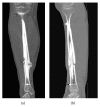Current Options for Determining Fracture Union
- PMID: 26556422
- PMCID: PMC4590948
- DOI: 10.1155/2014/708574
Current Options for Determining Fracture Union
Abstract
Determining whether a bone fracture is healed is one of the most important and fundamental clinical determinations made in orthopaedics. However, there are currently no standardized methods of assessing fracture union, which in turn has created significant disagreement among orthopaedic surgeons in both clinical and research settings. An extensive amount of research has been dedicated to finding novel and reliable ways of determining healing with some promising results. Recent advancements in imaging techniques and introduction of new radiographic scores have helped decrease the amount of disagreement on this topic among physicians. The knowledge gained from biomechanical studies of bone healing has helped us refine our tools and create more efficient and practical research instruments. Additionally, a deeper understanding of the molecular pathways involved in the bone healing process has led to emergence of serologic markers as possible candidates in assessment of fracture union. In addition to our current physician centered methods, patient-centered approaches assessing quality of life and function are gaining popularity in assessment of fracture union. Despite these advances, assessment of union remains an imperfect practice in the clinical setting. Therefore, clinicians need to draw on multiple modalities that directly and indirectly measure or correlate with bone healing when counseling patients.
Figures






References
-
- Einhorn T. A. Enhancement of fracture-healing. Journal of Bone and Joint Surgery. 1995;77(6):940–956. - PubMed
-
- Castillo R. C., Bosse M. J., MacKenzie E. J., Patterson B. M. Impact of smoking on fracture healing and risk of complications in limb-threatening open tibia fractures. Journal of Orthopaedic Trauma. 2005;19(3):151–157. - PubMed
Publication types
LinkOut - more resources
Full Text Sources
Other Literature Sources

